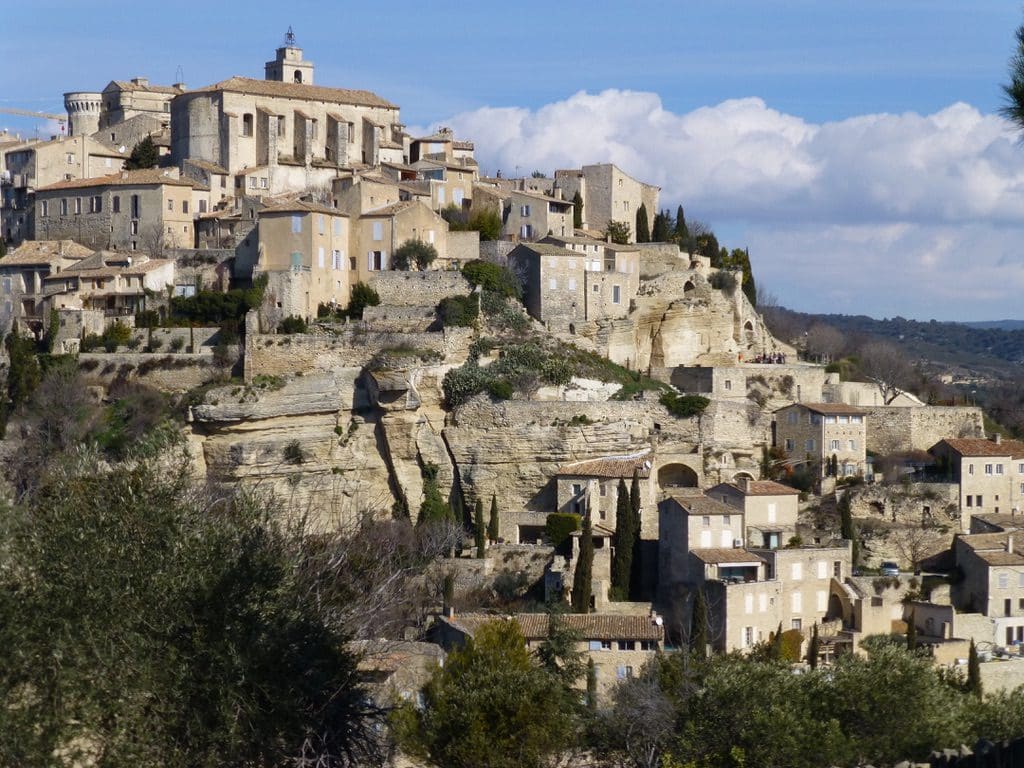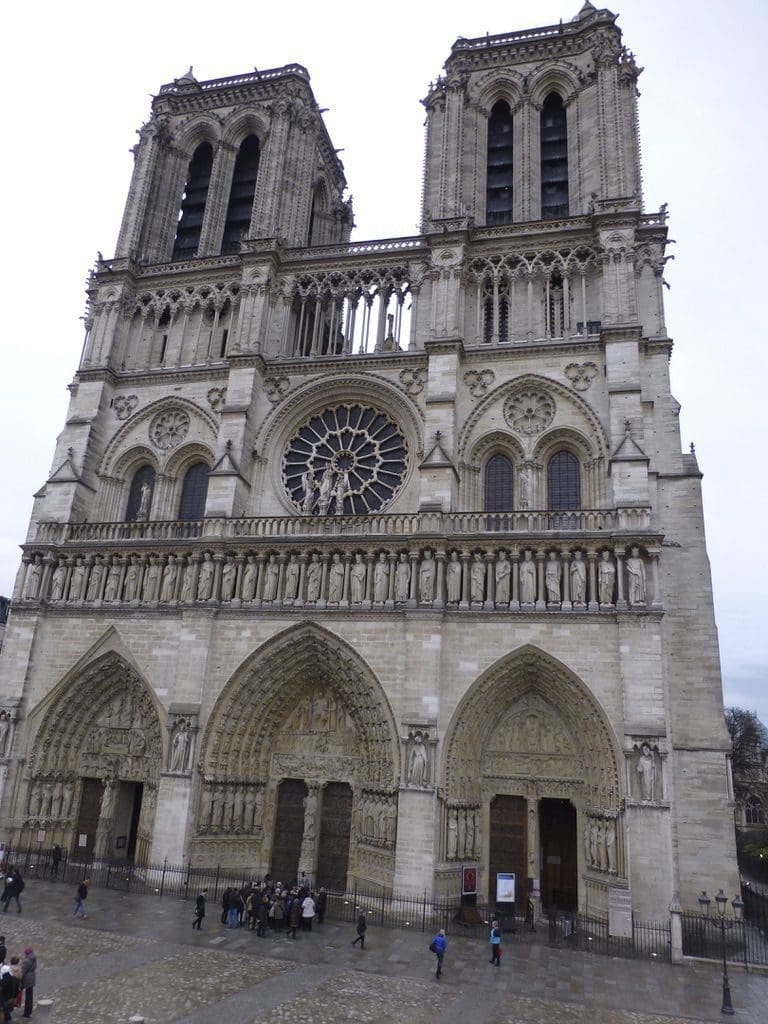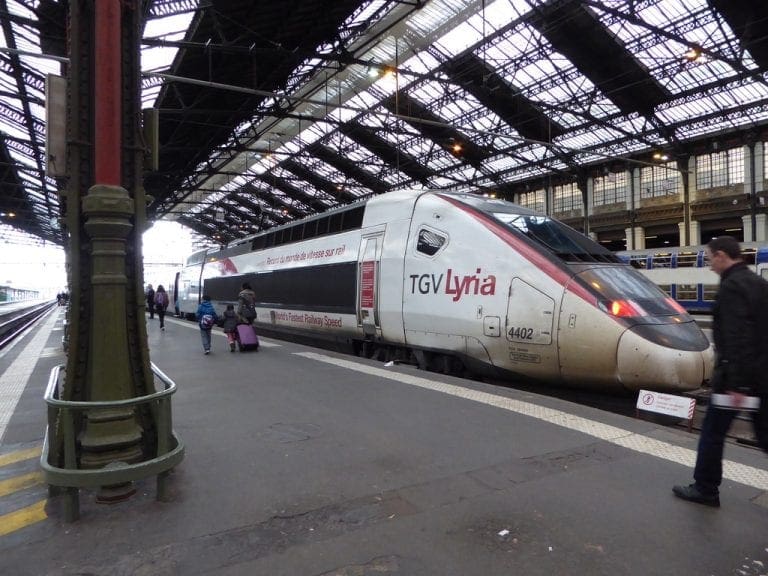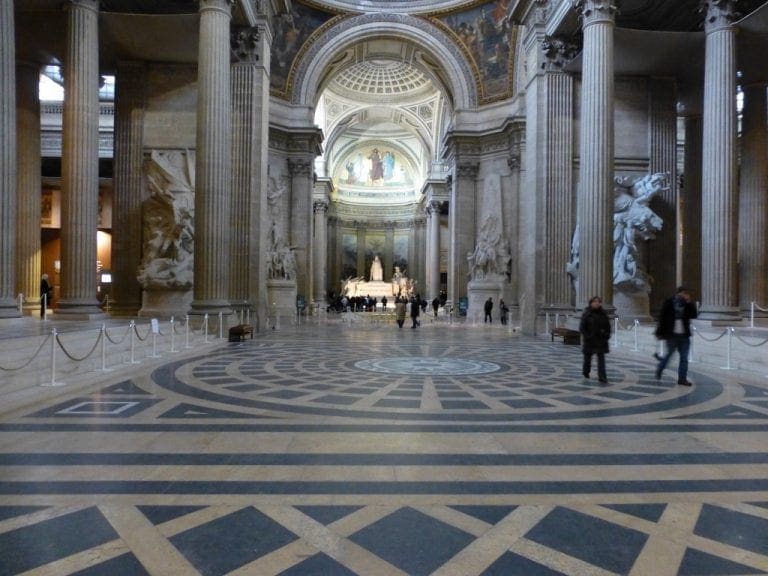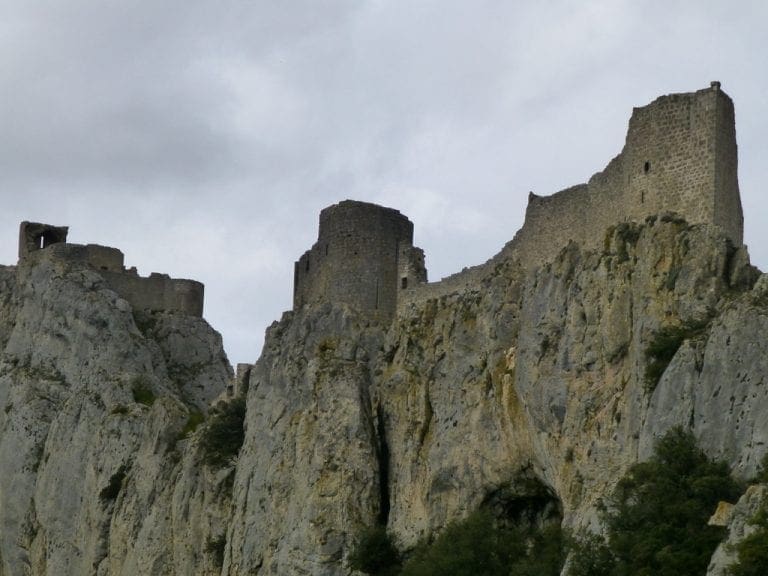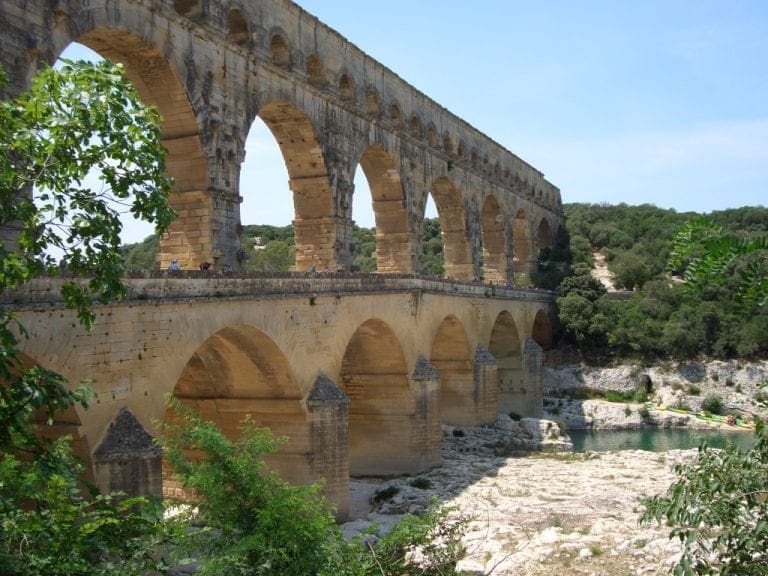France 2013 – week 3 – Sorgue
16 Feb 2013 Saturday. Day 15. Moving day. Up early at 6 in order to leave the apartment before 7 and catch the TGV from Gare du Lyon at 8:19. We had packed last night. It all worked very well. We left the apartment at 6:45, caught the Metro 8 to La Madeleine where we changed to Metro 14 (the newest and fully automated trains – not a driver or guard in sight) and arrived at Gare du Lyon at 7:15. (At no point did we have to carry our bags up anything – just down several set of stairs. Just as well for the gym.)
Followed signs to ‘Grande Lignes’. Followed signs to Hall 2, waited to see which platform we would be leaving from. That information came up at 7:50 and we sauntered down along the train to show our tickets and claim our seats. This huge station has 3 Halls (like wings in an airport terminal). This hall has 24 platforms – like departure gates. Departure boards show which hall the train will leave from and, when they know it, which platform. It might be a big day for us, but these trains do this three times a day each way. The train left at exactly 8:19. (While waiting for our platform number, Helen had gone for a walk and was lucky enough to see a train depart – with running passengers and an attendant saying ‘Vite, vite’. Dogs in special dog carry bags. Young men with skis, ski-helmet, goggles and ski boots climbing onto a train.
Before I get any further in this story of adventure, I would like to say how impressed I am with the Paris signage. In every Metro it is easy to see where to go for the correct line (Number and colour) and how to get out ‘Sortie’. If there is more that one Sortie, there is a map on the platform that tells you which Sortie goes where.
Back to the story. Our train charged along at 320 km/hr and passengers slept. i-am-tgv-very-fast-train
Today, we left the country of Pars and entered the country of France! From now in our journey, we will be in a more real France. I like to think that Paris is a separate country – then there is France. (For those of you who were rapt in Rick Steves’ Paris book, the lightheartedness and information of that book is continued in his France book; which, from now, we will be following.) We now begin what could be called ‘A week in Provence’. i-am-provence.html
At Marseille, where we arrived after what seemed like the blink of an eye, we followed the signs to the buses, caught our shuttle to the airport, had a bite to eat (at a very nice Brioche stand, next to the crowded! Burger King – who would believe the French are lining up for yankee junk food!), rang the number for the Citroen car and a few minutes later were being introduced to our new car. Citroen C4, Very nice. Recommended by Choir member Stan Thomas. (Nassim, the fellow at the Citroen outlet did an excellent job showing us over the car – what to press for what, what not to press.) The new car has 4km on the clock. Took a little while to get used to the sat nav – a couple of times round a roundabout and one u-turn where I turned right a fraction early. i-am-french-buy-back-leased-car
It all came together and we arrived without incident (even paid the toll on the motorway) at our next cottage for the week at Isle-sur-la-Sorgue. This is our first real cottage. For the next ten weeks we will be in villages. This cottage is narrow and on three levels – 1st floor has the kitchen and a sitting room, 2nd floor has our bedroom and bathroom, 3rd floor has second bed and a tv in the attic. I think it is 3 metres wide. €300 for the week. We look out onto the main village square where, tomorrow, there will be a famous market. It is certainly much warmer (and friendlier) here than Paris.
Once again, I am astounded by the friendliness of the welcome. Eric, showed us around and chatted for a good hour before reminding himself that he had to go back to work.
17 Feb 2013. Sunday. Day 16. A clear sky. 0C. Sunday is market day in Isle-sur-la-Sorgue and it is right outside our window. Mainly a produce market. We bought too much and made a lot of store owners very happy. Cheese was my downfall. Olives, lavender, wine, hams, saucisson, vegetables, apples, nougat, bread, dried tomatoes, paella. Between the food stalls – at least 5 cheese stalls and as many sausage stalls – were stalls selling shoes, knives, cloths, clothes, more shoes.

Today was the first real experience of driving the new Citroen on very narrow roads on the wrong side of the road. A bit unnerving. I found it difficult to get over to the right as far as I had to – it felt like I was driving in the ditch. We went to the famous Luberon hilltop village of Goudes. Essentially ghost town saved from obscurity in the 1960s and now a tourist mecca. I’m glad it is winter and the tourist crowds are not here. Doing what I did today would be very difficult on crowded roads. From there we went to the source of the River Sorgue at Fontaine de Vaucluse – very crowded with tourists so we came home and had our picnic inside. i-am-luberon-hill-village
18 Feb 2013. Monday. Day 17. Slightly cloudy. 12C. After yesterday’s hectic market day, today the village is closed – only bakeries open. We had decided to drive north to the Cotes du Rhone (sides of the Rhone River) wine road and villages and detour via Mont Ventoux. Unfortunately, it was a little hazy. We are becoming used to the inbuilt sat nav in the car – better than my Garmin but not as good as my Tom Tom. Yesterday’s practice on very narrow roads came in good stead for today’s narrow roads. It would have been a nightmare without the sat nav. With it, the passenger does not have to be a navigator – and just has to help the driver interpret the sat nav – which certainly does tend to invent roads to turn into (read farm tracks) and sometimes gets left and right confused. (Says ‘turn right’ while indicating ‘turn left’.)
Very rich farming country on very thin soil making use of every available metre of ground. Many plots of carefully tendered vines that are just having the last of their heavy prune before spring. Certainly, a lot of vine. All criss-crossed by a maze of roads that we, almost unerringly, made our way through.
Our first stop was the hillside fortress village of Seguret (from the Latin securitas). This village, like many in this area was fortified from the time of the fall of the Roman Empire here. Barbarians roamed the valley wanting to take anything good. This village had something to protect and built sturdy walls. They still needed sturdy walls through the middle ages and the wars of religion in the 1500s. We walked to the ruins of the ‘chateau’ right at the top of the hill – which was the place of final refuge in case of attack. Now, Seguret is a tourist stop with two large car parks outside of the walled, no vehicle access, village. I’m glad we were here in the off season. (Everything was closed.) This would be terrible in summer. This was to be our one big venture for the day. We continued round the wine road, looking from the road at the fortified hill village of Le Crestet (similar story) and turned off to visit Mont Ventoux. This is a famous Tour de France killer hill with gradients of 12% for a very long way up. We could only get to 10km from the top because of snow across the road. On the way down, we stopped at a table to have a picnic. Then, back via Le Col de la Chaine Mountain Pass with its views of Dentelles de Montmirail, to Suzette (which is a wine village overflowing with wineries – and no defensive wall), and back to Sorgue.
19 Feb 2013. Tuesday. Day 18. Clear sky. 12C. Beautiful day. Bit of a full day. We began by driving to the hilltop village of Roussillon – home of ochre. All these hilltop villages look a bit the same. They are all now beautiful. They once were working villages (or fortresses protecting the surrounding land). They were once all useful. Because of changes in politics, economy, technology, they each became abandoned and ghost-like. The French government, following prodding, threw money at them to build something for tourists to do and look at.

Voila, these beautiful villages – all classified and catalogued. Seguret was a fortresses. Roussillon was an ochre mine – run a bit like sand mining was done on Stradbroke. The ochre here is in the soft clay in sand dunes. Pump water at it with force, wash the clay/ochre into vats, let it settle and dry. Sell it. It was sold world wide from 1882 to 1943. Then the distinctive ochre was replaced by chemicals. It could have been the start of terra cotta. Certainly looks like it. Winter is the time (absent of tourists) when these hill-top villages do their restoration/renovation. There was hardly a house in Roussillon without a van outside and a workman inside. Beside us, tourists were few – and those almost all French. We walked through the old diggings. Did the long (50 minute) tour – which was down and up many steps.
Then, Mont Ventoux – again – from the other side. i-am-mont-ventoux This is the way the cyclists usually tackle it. We drove up the narrow winding road to where it was blocked by ‘le barrie’ 4 km from the top. We walked up 2 of those very steep kilometres towards the top. Those bike riders certainly do it tough. It was hard enough to stroll up the road, let alone race up it on a push bike. It got gradually more steep, and we turned back. The history of the Tour de France has been much tied to this hill. Drug use was common from the earliest days of the Tour just to get up the thing.
Very tired little bunnies after those two walks. Then the long drive back to Sorgue and a beer, a few slices of cheese, a cup of soup, a few olives, a few slices of nougat…
20 Feb 2013. Wednesday. Day 19. Clear sky. 12C. A day off. We wandered around L’Isle-sur-la-Sorgue – followed the ‘waterwheel’ tour from the village’s map. i-am-a-waterwheel-on-isle-sur-la-sorgue This used to be a busy town powered by water. Now, the water wheels turn as reminders of by-gone glory and for tourists to have something to look at. We gradually made our way to the Basin where the River Sorgue crashes into the town, diverges and is pacified into canals. At this junction of roads, river and canals there is a Provence provender shoppe that had caught Helen’s eye. Olives, olive oil, tapenade, jam, sun-dried tomatoes, peppers, lavender and honey. (I very much like the lavender honey. The chestnut honey has slowly grown on me.) Then, the real target for the day – the lunch spot for the Plat du Jour. Today, we went to the recommended ‘au Chineur’ for an excellent meal. Crowded and sewing machine tables for tables.
Suddenly, half the noisy outside crowd got up and re-started work on the restaurant next door – arc-welding and sledgehammers. We did nothing for the rest of the day so as to recover.
L’Isle-sur-la-Sorgue is a very pleasant village – a maze of one-way streets on the island itself. Sprawling outside the island in new development. The island itself is about 300m by 200m. Our little ‘apartment’ (Luberon sun) is right in the middle, right on the village square and looks down on the twice weekly market. It is ideally located to explore the Luberon and Vaucluse. Very friendly, thoughtful and helpful owners. Clean and tidy – there is a stack of helpful information about what to see and do, what is on where and when.
21 Feb 2013. Thursday. Day 20. Clear sky. 12C. Market day again in L’Isle-sur-la-Sorgue (two markets a week – Sunday (the big one), Wednesday (smaller)). We strolled through saying hello to the people who had sold things to us on Sunday. We went out with the idea we were to buy flowers, wine, apples and ham – and maybe a few other things we saw. €200 later we returned. A very friendly place. Stall holders are certainly practical when they can see a customer. The locals are becoming excited about the ‘Truffle festival market’ which is on here this Sunday. We will miss it. Damn.
Renovation (with a masonry drill) has begun on the downstairs apartment that shares our very narrow winding stairway. A good day to be out of here. We went for a walk in the ‘Forest of Cedars’ just south of Bonnieux – recommended by our landlord. Quite a nice walk down and up through a little snow to a view over the River Rhone. A clear day but an inversion has trapped the haze. Bonnieux and Lacoste certainly look like lovely hill-top towns.
I was just looking over the photos for the week. 345 so far just this week! Bruce is right. Take your photos on the first day and the first time you see something. After that, you get used to it, it becomes normal, not interesting and you won’t take the photo.
We like our little village and where we are. The village is still alive, quiet, but still alive. It certainly revolves around it twice-weekly market.

22 Feb 2013. Friday. Day 21. Clear sky. -3C to a high of 7C with a cold wind – feels 5 degrees colder. Ice on the car this morning. We headed to Orange to view the Roman Amphitheatre and its Arc de Triomphe. There is not much else in Orange these days. In Roman times, this was a thriving retirement village for ex-legionnaires. It was pillaged and burn by visigoths in 412. The Amphitheatre was built by Augustin in 35BC – to give them circuses. In its heyday, 180 days of theatre a year were performed here to audiences of up to 10,000. It must have been a biggish and busy retirement village to be able to turn out 10,000 for 180 days of the years.
Those performance must have been only held in summer. Today, it was bloody cold anywhere in the theatre – which had an interesting way of channeling the wind (as well as excellent acoustics) to make everywhere cold. The back/front wall of the theatre is all that remains and it is in not bad condition for a 2,000 year old wall. Performances are still held here – in the restored amphitheatre. Because of the cold, we were pleased to leave, but it must be delightful here on a hot summer’s day. We then drove 1/2 kilometre north of town the visit the Arc de Triomphe built by Germanicus in 20 BC. Impressive. Orange was the sight of a huge battle that changed history – 120,000 Romans and allies killed in the day. i-am-battle-of-arausio
We had our first experience with ‘paid’ parking today. We opted for a 1 1/2 hour time thinking that we seldom spend that long doing anything. We were interested enough in the amphitheatre to overstay that time. Next time, we will take the maximum for a few cents more. Also our first real experience with the motorways. I certainly have not worked out which gate to use to pay. I reversed out of one today when there was no way to pay. I saw another car do that a few days ago. The traffic is obviously used to it. A car trying to reverse out of a pay station is just something to avoid. It could be you tomorrow.
While we’ve been here, we’ve each read Peter Mayle’s ‘A Year in Provence’. It could more accurately have been titled ‘A Year in Luberon’. The little community he describes is just a few kilometres east of here. We see the people every day. The market here in Isle-su-la-Sorgue is one of the markets that he describes.
Today, Helen saw a good example of a French greeting. Two builders vans approached each other. Builders got out of driver’s seats, embraced and gave each other 4 kisses. Assistants gave builders 3 kisses. The jeune (apprentice) shook hands (after pulling back his hoodie). A French pecking order?
Thus ends another week. Three down, nine to go. Tomorrow, we change regions, but touristically we stay in Provence. For the next few days, our focus could be Roman.
